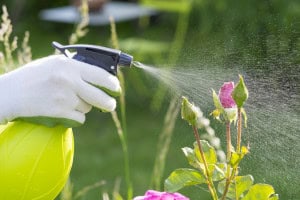Early Detection is Key for Solving Landscaping Insect and Disease Infestations
Share:
WARNING: This year is going to be a year of plant pest and diseases running rampant, as temperatures and moisture are ideal for breeding and spreading them. Add to that the fact that the past mild winter also allowed for carry over of insect populations and diseases from the previous growing season.
Whether it is plants, shrubs, trees or sod – all of your landscape could be at risk for insect or disease infestations that could lead to costly consequences. Landscaping is an investment and regular maintenance is necessary to protect that investment.

Part of being able to identify potential infestations is to be familiar with your vegetation’s healthy appearance and the history of previous pest or pathogen problems on your property. As alluded to earlier, many fungal pathogens and pests may overwinter in soil or debris. Nursery plants may also introduce unwanted organisms to your soil.
Some of the symptoms or signs of disease or insect infestation are chewed foliage, wilting, yellowing/browning foliage, excessive resin/sap production, spotting, boreholes, discoloration, defoliation, stunting and dieback of twigs, shoots, entire stems or plant.
With hundreds of inspect species, it might be hard to identify the ones that are damaging parasites versus the ones that are beneficial pollinators. Keep in mind that 95% of insects are helpful or harmless. In the northeastern United States’ the top ten threatening insects and arthropods are the Hemlock Wooly Adelgid, Winter Moths, Japanese Beetles, Asian Long-horned Beetles, Southern Pine Beetles, Emerald Ash Borer, Weevils, Spider Mites and Scale Insects.
Likewise, the top ten diseases that threaten the northeastern United States are Bacterial Leaf Scorch, Phytophthora Root Rot, Dutch Elm Disease, Leaf Spot Disease, Anthracnose, Needlecast, Verticillium Wilt, fire Blight, Powdery Mildew, Bleeding Canker and Phytophthora Canker.
Other factors that can wreak havoc on your plantings are environmental stresses – drought and extreme heat.

An integrated approach to managing insects and diseases starts with maintaining plant health by pruning and maintaining soil conditions for plant growth. Periodic inspections are paramount for early detection of pest and disease infestations before they reach damaging levels.
DiSabatino Landscaping can help you with identification and potential treatment options. A quick response can prevent the spread of insect and disease pathogens to keep damage to a minimum and allaying the treatment costs. Get in touch today – 302-764-0480
Article details:
- Published by:
- DiSabatino Landscaping
- Published to:
- Last modified: July 11, 2017
Share:
Continue learning:



